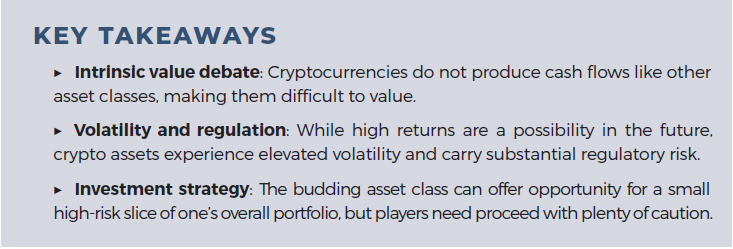
“I think it is rat poison!” Not mincing any words on May 6, 2013, when asked what he thought about Bitcoin on Fox Business News, Charlie Munger proclaimed that he regarded the cryptocurrency as “deeply flaky.”
The price of Bitcoin was then $109.
Nearly a decade later, the late Berkshire Hathaway Vice-Chair, doubled down on his disdain, stating, “Of course I hate the Bitcoin success. I don’t welcome a currency that’s so useful to kidnappers and extortionists and so forth, nor do I like just shuffling out a few extra billions of billions of dollars to somebody who just invented a new financial product out of thin air.”
By then, Bitcoin had risen to $57,000
Obviously, great fortunes were made by early adopters. And with Bitcoin having traded above $70,000 recently, while advocates trumpet a potential six- or even seven-figure price tag down the road, plenty of folks young and old have come to believe in the investment prospects of digital currencies.
INTRINSIC VALUE
We have been asked on numerous occasions for our take on crypto and each time our response has echoed what Mr. Munger more calmly stated a few years back, “It’s really kind of an artificial substitute for gold. And since I never buy any gold, I never buy any Bitcoin.”
In short, Bitcoin and other cryptocurrencies, as is true of gold, produce no income, making these assets impossible to value from our way of thinking. At the end of the day, they are worth what someone will pay for them, with gold at least providing some utility via its usage in jewelry, electronics, and dentistry, not to mention its 2,000-year history as a store of value.
But that hardly means that cryptocurrencies have no value…as long as there are others who think they have value!
To be sure, digital asset fans will argue that Bitcoin and other cryptocurrencies are storehouses of value in a world filled with disconcerting headlines and constant geopolitical drama. There is also something to be said for decentralized finance, though we are a long way from digital wallets being used around the world to pay for a loaf of bread or gallon of milk.
Our asset class of choice, equities, on the other hand, offer an ownership stake in corporations that generate sales and earnings, which allow businesses to return capital to shareholders via dividends and stock repurchases, while continuing to invest cash into growing their enterprises. True, stock prices have always been volatile, going through more than few booms and busts, but they generally have tracked economic growth and corporate profits higher over the long term.
And other asset classes like bonds come with interest payments and a claim on the repayment of principal, while real estate usually provides rent/lease payments, utility in business and/or a roof over one’s head. We can value these instruments as they have income streams.
We have no way of knowing if Bitcoin is worth seventy thousand dollars or seventy cents!
Of course, we also have no way of validating that the Michael Jordan Logoman trading card was worth the $2.928 million at which it just sold, or that the Princess Beanie Baby listed for sale on Poshmark for $500,000 is a bargain.
Obviously, there are many assets that do not generate any income and we can turn to the art world for even more astronomical price tags, with Leonard da Vinci’s Salvator Mundi fetching a record $450.3 million at auction in 2017. No doubt, many will argue that works by the great masters are worth every penny as Michelangelo said, “The true work of art is but a shadow of the divine perfection.” However, such was not always the case as it is said that Gauguin, Rembrandt, Vermeer, van Gogh and Monet all died poor.
At the end of the day, we will stay in our lane, leaving digital currency investments to others as we continue to think Paul Samuelson had it right, “Investing should be like watching paint dry or watching grass grow. If you want excitement, take $800 and go to Las Vegas.”
HEADING TO SIN CITY
We respect that many can’t resist the temptation to get involved in the cryptocurrency game for a small portion, hopefully, of an overall investment allocation that can tolerate wild price gyrations and substantial risk of loss of principal. So, we offer a list of high-level considerations that we believe apply across the asset class.
Volatility: Cryptocurrency investments can have extreme price fluctuations. While few complain of price fluctuations when prices are rising, the table shows heavy losses up to 95% in some years (and up to 94% in 2022 amid broad crypto struggles) and investors should be able to withstand such gyrations.
Market Dynamics: Crypto investments trade at all hours, meaning that conventional trading strategies may not apply. With price changes happening 24/7, it is important to have a steady hand.
Liquidity & Transaction Costs: Some cryptocurrencies have lower liquidity than publicly traded stocks or bonds, which can lead to larger price swings when transacting. In addition, network, spread and wallet fees are usually charged, adding up to 2% or more.
Regulation and Legal Status: Regulators and lawmakers tend to move slowly, meaning tax, holding rules and the general treatment of cryptocurrency wallets is not set in stone. This brings additional risks, as regulators and governments sort out the path forward.
Technology: The blockchain, or foundation on which cryptocurrencies have been built, is a budding technology. Applications for blockchain reach far and wide, while a firm understanding of the basics is imperative for investors with crypto exposure.
Security: A fundamental distrust of centralized currencies and central banks was a primary point of popularity among early cryptocurrency investors. Long passwords, keys and other safeguards are essential to investing success, especially as there’s limited recourse in case items end up in the wrong hands.
Investing and Diversification: Cryptocurrencies are relatively new to the investment world but have quickly found a home among the other major asset classes. Propelled by worldwide popularity, cryptocurrency investments can be made directly, through ETFs and in select retirement accounts. Over the years, we have stressed the importance of broad diversification and crypto investors would be wise to apply similar principles in their investment portfolios. Even over the same time periods, returns vary widely. In 2021, for example, Bitcoin gained 60%, while Dogecoin gained 3,526%.
Risks and Reward Considerations: Cryptocurrency investments are inherently risky. Over the last decade or so, investors have been sufficiently compensated for risk-taking activities in the form of enormous returns. Whether that will continue in the future is anyone’s guess, and we would not ignore Warren Buffett’s famous admonition, “A pin lies in wait for every bubble and when the two eventually meet, a new wave of investors learns some very old lessons.”
PROCEED WITH A FOCUS ON THE LONG TERM
While we will always remain focused on our broadly diversified portfolios of what we believe to be undervalued stocks, we can appreciate the allure of digital currencies. The budding asset class can offer opportunity for a small, high-risk slice of one’s overall portfolio, but players should proceed with plenty of caution.
Indeed, Money.com reported last year that 1,900 crypto projects listed on the site of crypto aggregator CoinGecko in 2022 had already failed, while former crypto titans Sam Bankman-Fried and CZ Zhao are in prison.
And we can’t forget the tale of woe of Stefan Thomas, who supposedly lost the password for an encrypted USB drive holding 7,002 Bitcoins, which as of this writing would be worth nearly $500 million!
Cryptocurrency Investing
Kovitz Investment Group Partners, LLC (“Kovitz”) is an investment adviser registered with the Securities and Exchange Commission. This report should only be considered as a tool in any investment decision and should not be used by itself to make investment decisions. Opinions expressed are only our current opinions or our opinions on the posting date. Any graphs, data, or information in this publication are considered reliably sourced, but no representation is made that it is accurate or complete and should not be relied upon as such. This information is subject to change without notice at any time, based on market and other conditions. Past performance is not indicative of future results, which may vary.





